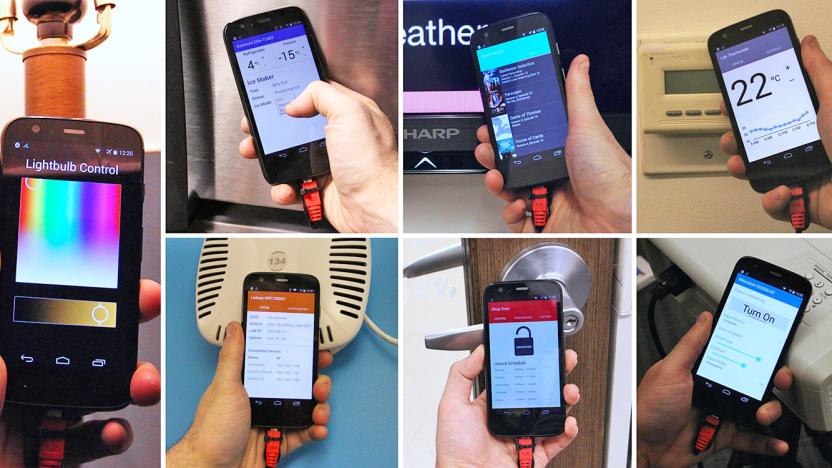em
Latest

Future phones will ID devices by their electromagnetic fields
While NFC has become a standard feature on Android phones these days, it is only as convenient as it is available on the other end, not to mention the awkwardness of aligning the antennas as well. As such, Carnegie Mellon University's Future Interfaces Group is proposing a working concept that's practically the next evolution of NFC: electromagnetic emissions sensing. You see, as Disney Research already pointed out last year, each piece of electrical device has its own unique electromagnetic field, so this characteristic alone can be used as an ID so long as the device isn't truly powered off. With a little hardware and software magic, the team has come up with a prototype smartphone -- a modified Moto G from 2013 -- fitted with electromagnetic-sensing capability, so that it can recognize any electronic device by simply tapping on one.

Editorial: How FAA-certified gadgets could improve air travel and eliminate the Terrible 10,000 Feet
If you're reading this now and have experienced the wonders of modern air travel then you have surely suffered through what I call the "Terrible 10,000 Feet." This is the period between the clunk of the cabin door closing and the bong of the cabin indicator, the chime signifying arrival of the magic altitude where "approved electronic devices" can then be used again. The first half of the worst part of the flight is then over -- the latter half to commence as soon as the plane dips again below that gadget ceiling. This is the loudest part of the flight -- engines throttled up, flaps and gear hanging in the breeze and scared kids doing their best to drown all that out with screams and shouts. It's exactly when you most want to use your portable music player, and exactly when you aren't allowed. We've been told that this is for safety reasons, to prevent interference from the myriad devices carried by a cabin full of passengers, but that's never quite felt satisfactory to me. (Why is it okay to use those very same devices over 10,000 feet? Why can pilots use iPads but I can't?) So many questions, but I'm not here to second-guess the people whose jobs it is to keep me safe as I schlep myself, my roller bag and my personal item across the country yet again. I'm here to propose a very simple solution: a certification program in which manufacturers submit devices for testing and the FAA charges a (possibly hefty) fee for their approval. It could not only improve the lives of frequent travellers like myself, but could also stand to provide millions in funding to the FAA, funds that could be put toward its unfortunately named NextGen air traffic control system. Win win? Read on and decide for yourself.

Santa Fe WiFi foe strikes again: sues neighbor for using wireless devices, lives in a car
No, this isn't him, because the real Arthur Firstenberg (with or without a cat) would probably need more than an aluminum helmet to cure his "electromagnetic sensitivity," symptoms of which allegedly include stomach pains and memory loss. In fact, this man -- an active member of the anti-wireless group in Sante Fe -- has taken one step further by suing his bewildered neighbor 25 feet away for refusing to switch off her wireless devices, which he claims has forced him to stay at friends' or live in a car. We'd say just chill out, find some place in the middle of an African desert, and then fly out. Oh, wait. [Photo courtesy of Wally Glenn]

Santa Fe group allergic to RF wants WiFi banned
We've been hearing for years of that certain elusive breed of human that is extra-sensitive to certain radio frequencies and electromagnetic fields, so it was only a time before those wire-tethered folks took shot across our wireless-loving bow. According to a local NBC news affiliate, Sante Fe resident Arthur Firstenberg (not pictured right) has organized a group of electro-sensitive citizens to rally against WiFi and cellphone use in public space, claiming it violates the Americans with Disabilities Act. No doubt it is indeed a sticky situation, but we're pretty sure Firstenberg and co are going to have to do a little better than claiming to "get chest pain and it doesn't go away right away" if they really expect an entire city (or country) to cease using wireless communications. [Via Fark]

